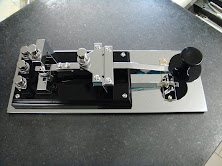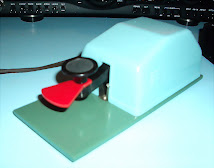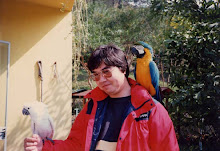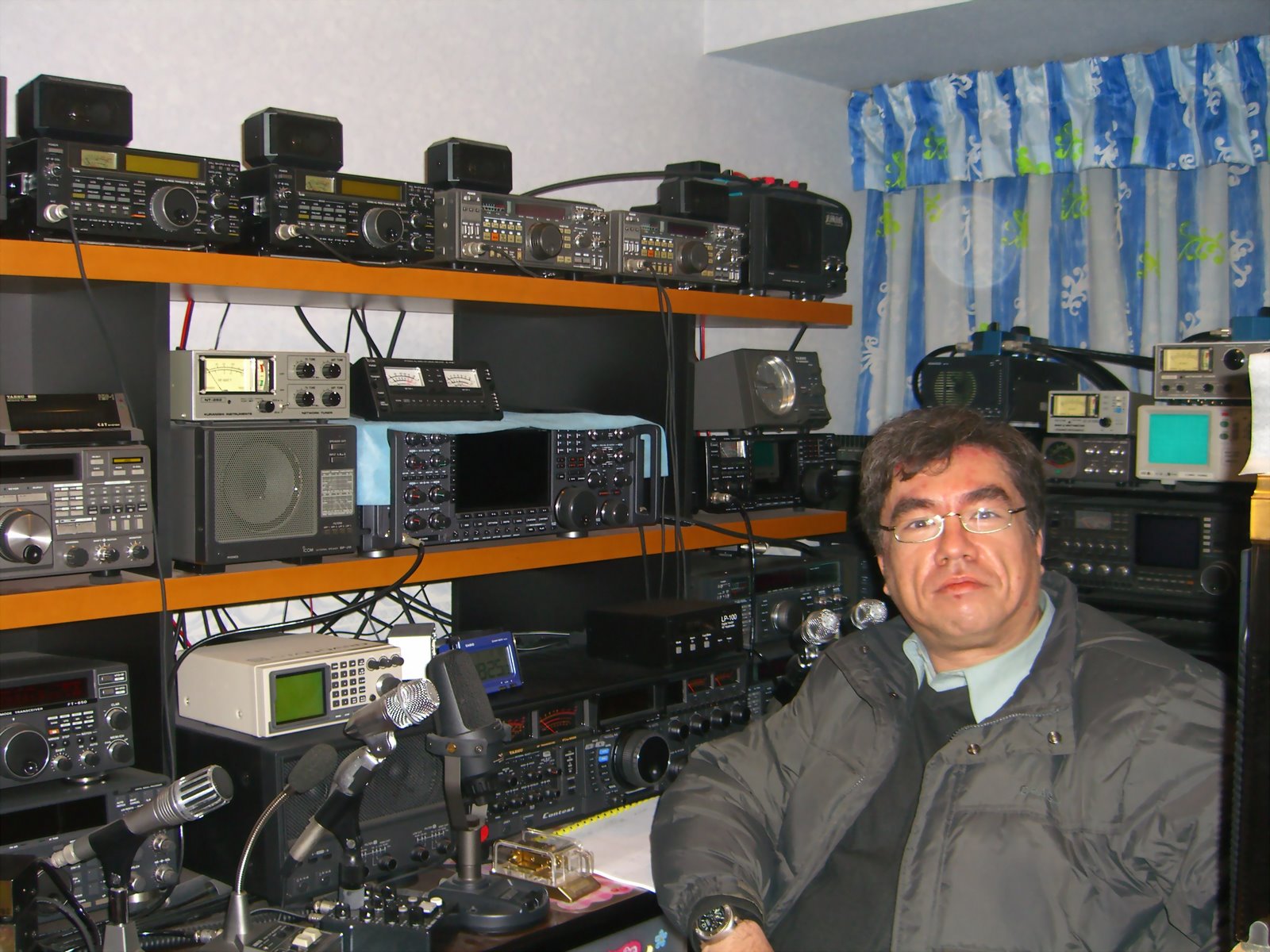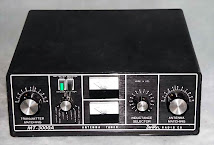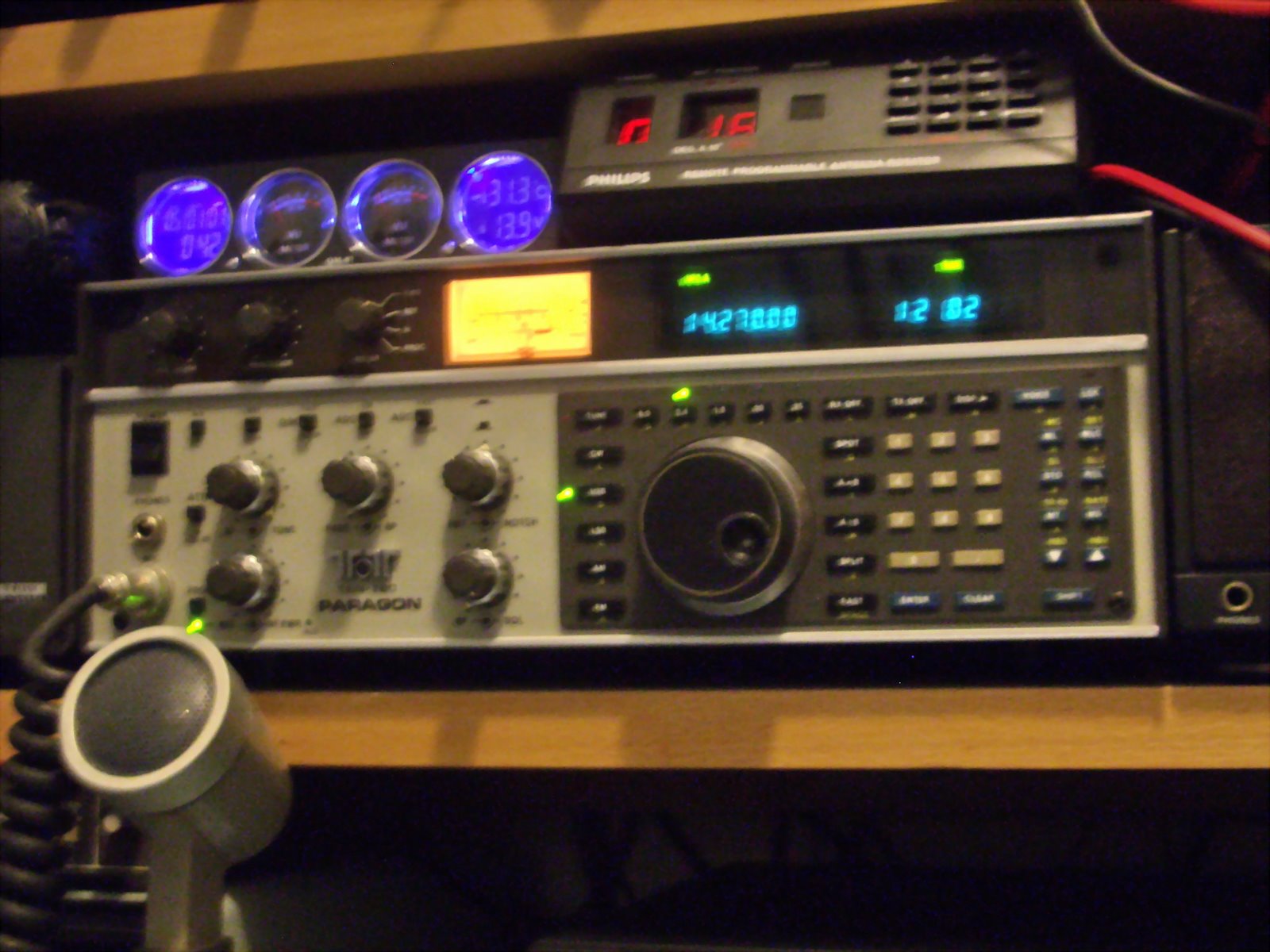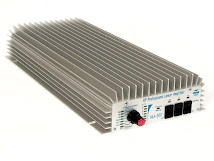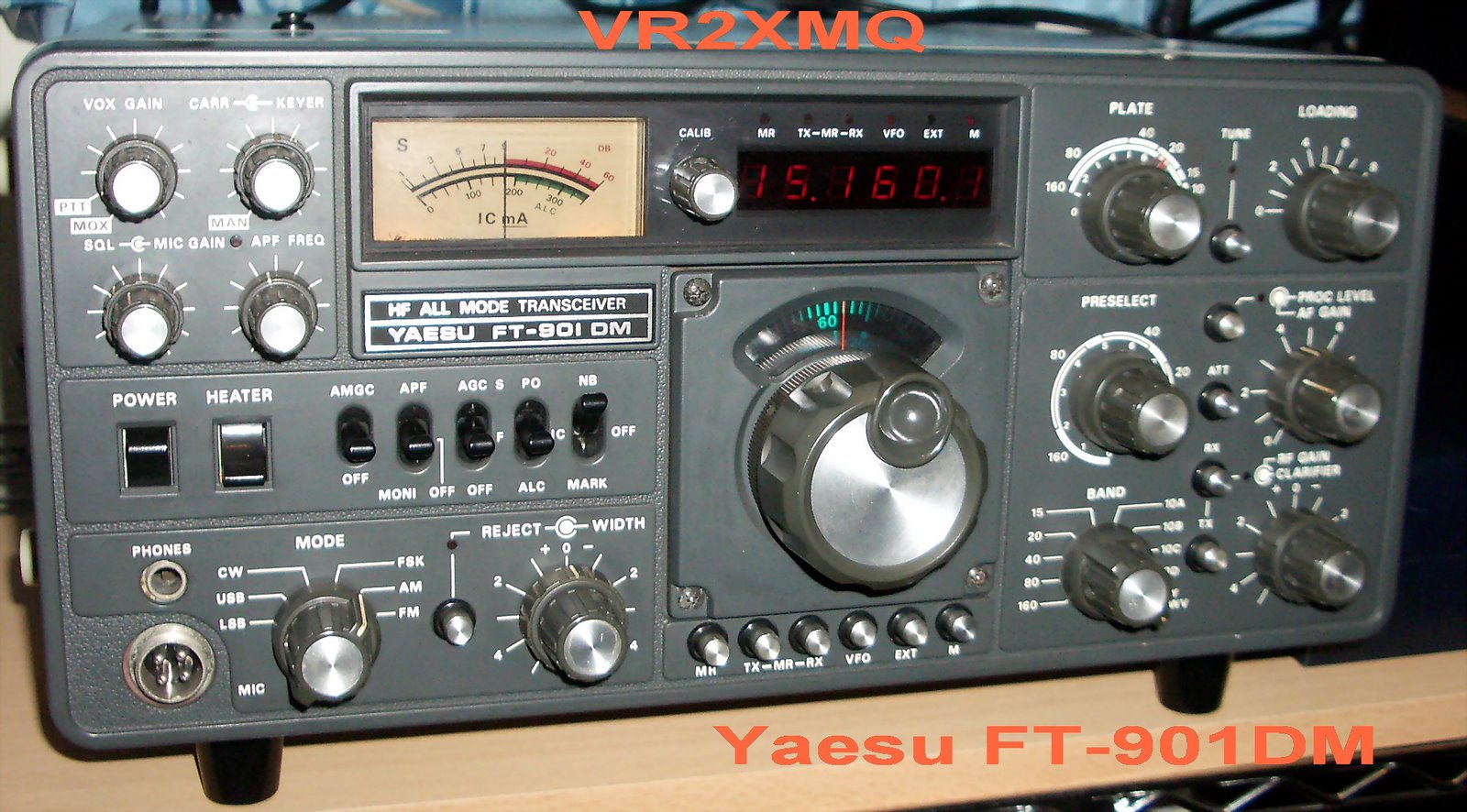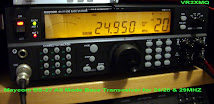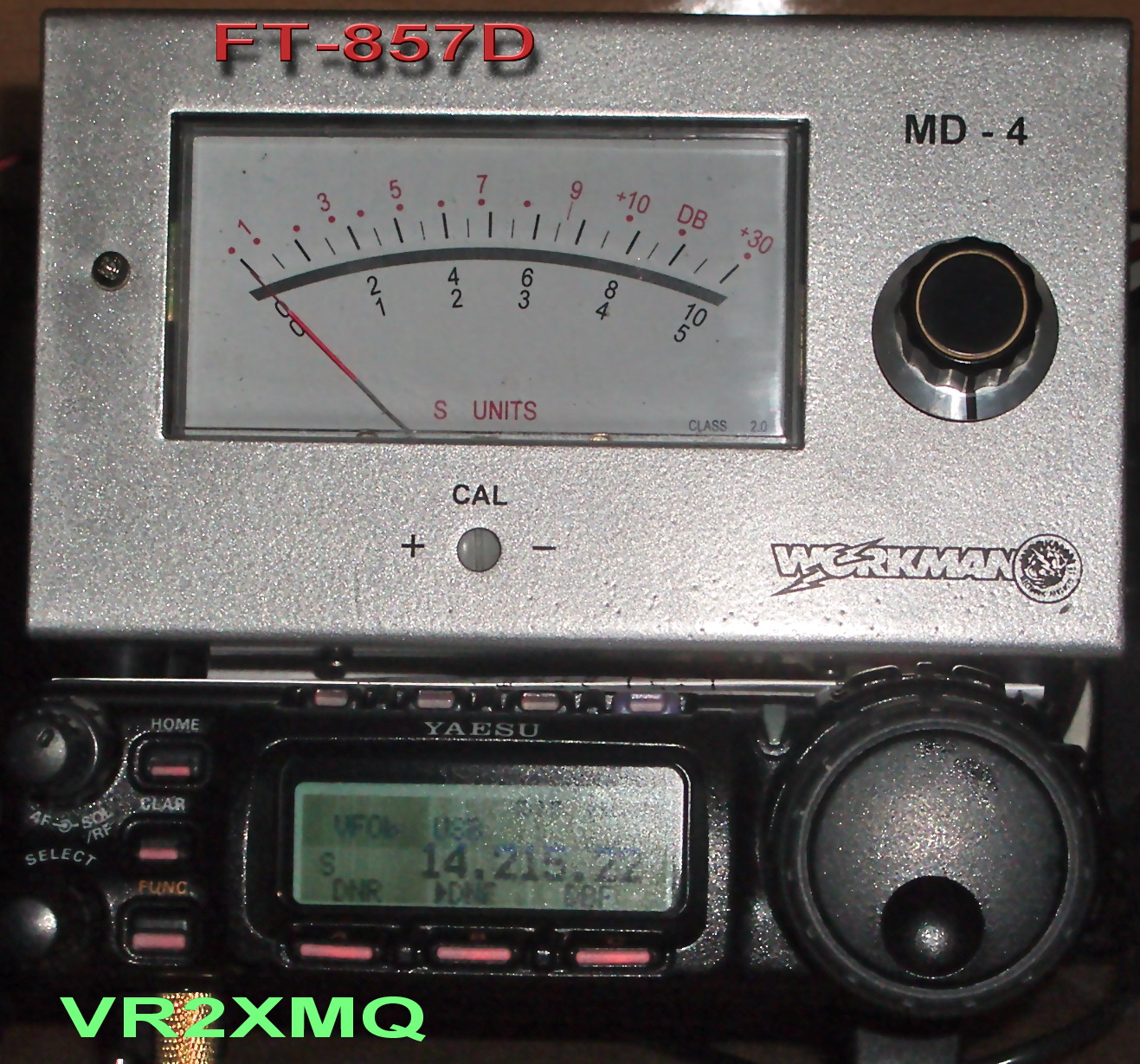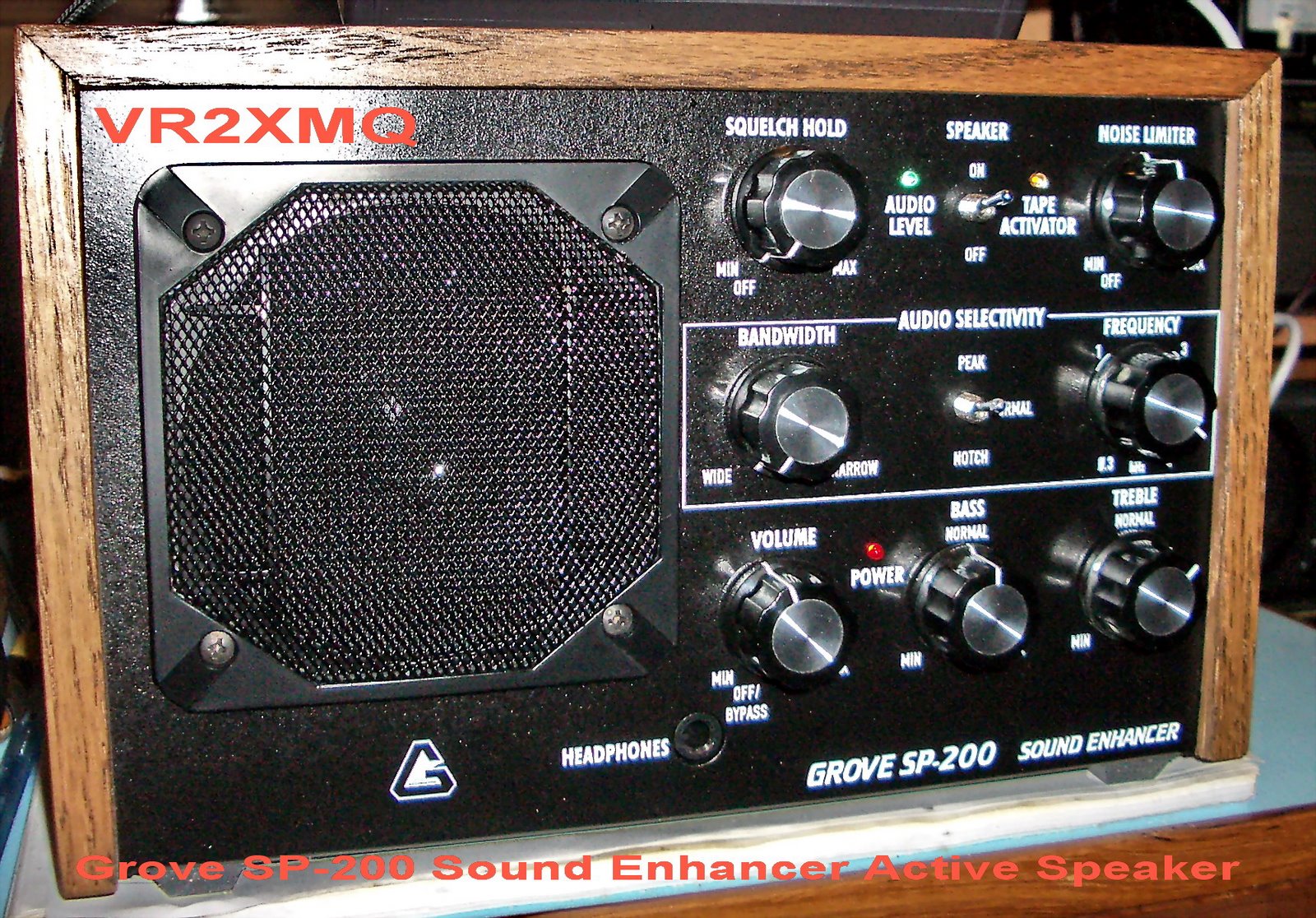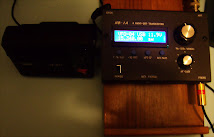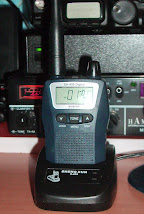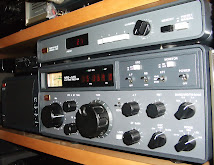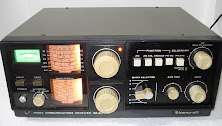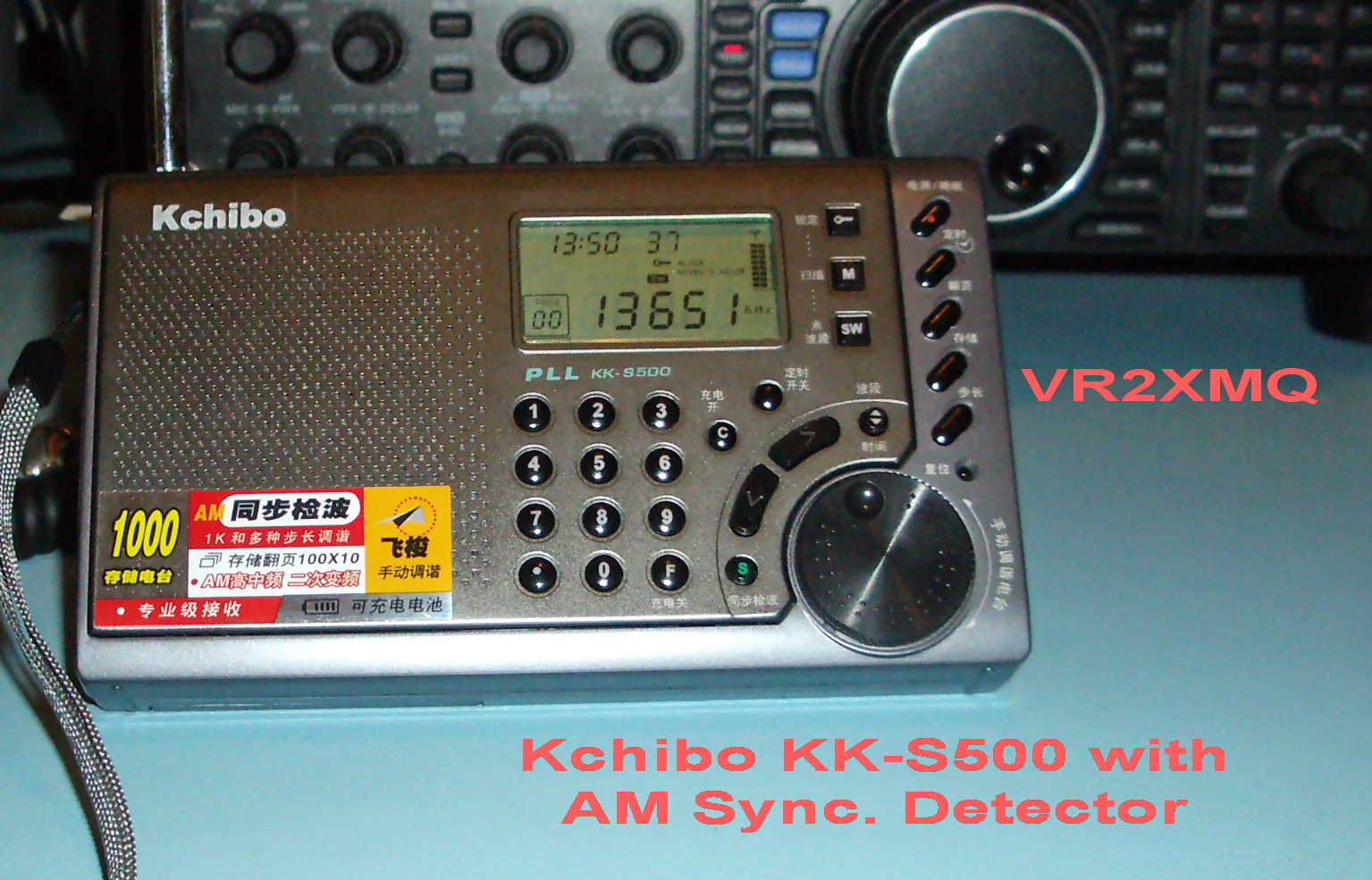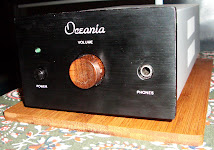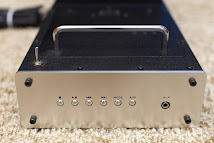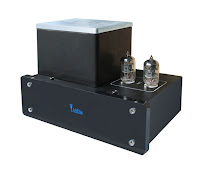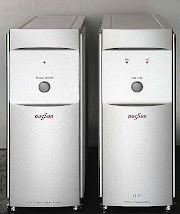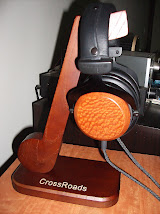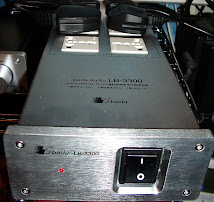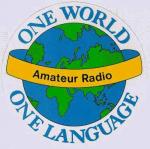Thursday, July 31, 2008
Wednesday, July 30, 2008
Playing with sound enhancers for Hi-End PC Audio Playback

Sunday, July 27, 2008
More on 3D Sound Enhancement for the computer.
http://www.3dsoundstore.com/www-3dsoundstore-com/demo-qmax2.asp
The QMax II plug-in is a product of QSound. You can also find QSound at: http://www.qsound.com/

DFX Sound Enhancer
Below is the hype from the DFX website, and it is worthwhile doing the download:

Friday, July 25, 2008
Integrity
Sunday, July 20, 2008
Refurbished 4 Element 6 Meter HB9CV Yagi Antenna
 This weekend we finally had two days of clear skies so it was great because I could do the refurbishment work on my 4 element HB9CV yagi antenna for 50MHz. Everything is completed now and the antenna will be set up for a permanent direction to NA now. The photos below show the antenna completed in it's final stages on a test tripod. All the elements have been changed with new ones and resizing of the spacings done.
This weekend we finally had two days of clear skies so it was great because I could do the refurbishment work on my 4 element HB9CV yagi antenna for 50MHz. Everything is completed now and the antenna will be set up for a permanent direction to NA now. The photos below show the antenna completed in it's final stages on a test tripod. All the elements have been changed with new ones and resizing of the spacings done.
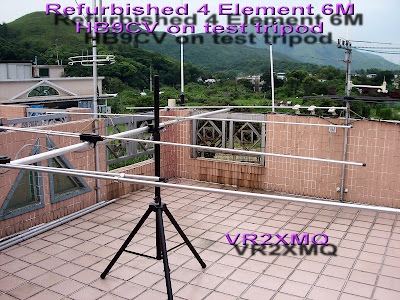
Maycom BS-27 All Mode Base Transceiver for 24/28/29MHz

It is marketed in Europe as the Stabo XF-9082 professional ans also elsewhere as the Superstar SS-4900, they are all the same radio.
So you may ask why the fuss over a glorified CB radio. Ahh, this is where you are wrong. I somehow beleive that the engineers at Maycom are hams and the rig can be changed for "full entire coverage" from 24MHz through to 30MHz!!!! Yes, you have a transceiver that covers 24MHz, 28 and 29MHz! Neat!
So how is this accomplished, easy push the EMG button whilst you turn the power on and presto you have full band coverage! It is a nice base station to have for 24 and 28MHz. I hope the people at Maycom are listening and reading this, it is time for you guys to design something for 50MHz! Or may be a combined all mode transceiver that covers 50MHz and 70MHz (6 meters and 4 meters).

1. GENERAL
FREQUENCY COVERAGE ......................... 26.965 TO 27.405 MHz
FREQUENCY GENERATION ...................... BY MEANS OF PLL SYNTHESIZER
FREQUENCY STABILITY ........................... +/- 0 . 0 0 1 %
OPERATING MPERATURE .........................-10℃ TO +55℃
POWER SOURCE REQUIREMENTS ........... AC 230V/60Hz or DC 16V
ANTENNA IMPEDANCE ............................ 50 ohm Unbalanced
MIC IMPEDANCE ..................................... 2000 ohm
2. RECEIVER SECTION
CIRCUIT TYPE .............................. DUAL CONVERSION SUPERHETERODYNE
IF FREQUENCY ............................ 1'st IF : 10.695MHz , 2'nd IF : 455KHz
SENSITIVITY ......FM:0.5uV FOR 20dB SINAD,With CCITT FILTER/ AM:0.7uV FOR 10dB NQ/ SSB:0.15uV FOR 10dB NQ
SPURIOUS & IMAGE REJECTION ................60dB Min
INTER MODULATION DISTORTION ..............54dB Min.
S / N RATIO .............................................40 dB
AUDIO OUTPUT @10%THD ........................2.0 W
3. TRANSMITTER SECTION (Published)
POWER OUTPUT ............................SSB(A3J):25Watts. AM(A3E):1-10Watts. FM(F3E):10Watts
MODULATION .................................FM :2KHZ, AM : 8 5 %
HARMONIC OUTPUT .......................More than 40Dbbelow peak power output
S / N RATIO ..................................40dB
Are You An Otaku, I hope not

Sometimes we see these kind of people in the world of radio or hobbies, we call them Otaku, in Japanese, meaning that he is a maniac, too much of an enthusiast that he walks over everyone else and friends, far too into their hobby or enjoyments, and does not see anyone around them (they are in a dream world and think that only they are no. 1 and everyone else is below them).
In Japanese it occasionally suggests a creepy, obsessive loner who rarely leaves the house. In English, geek can possibly suggest a person who may be socially awkward but who is also intelligent and may be fairly "normal" aside from their interest in certain typically 'geekish' pursuits. Otaku is not completely the same as the meaning for Geek.
An Otaku is self obsessed with his particular pursuit to the point that he could forsake friendships and in order to strive for his particular goal turn against long time friends. Otaku is far worse then the word geek as their judgments a not level headed and they cannot admit to what is right or wrong. They are too self centered.
The reason that I have raised this is because there are "Ham Otaku's' who are reclusive, live in their shacks all the time, turn against friends in pursuit of the hobby to the extreme and are just plain ignorant, arrogant and repulsive, bad mannered, selfish and full of themselves (mislead by a euphoria of their own self indulgent greatness). Plainly - Ham Morons!
It is so very unfortunate that I have had the chance of knowing at least one super "Ham Otaku"!
Saturday, July 19, 2008
Old Flames Die Hard: Maycom EM27


Features :
- Frequency and channel display
- Large LCD multi function display
- Full channel or memory channels scan or only preset memory channels
- Automatic control of low audio level in accordance with noise strength
- Dual watch
- Key lock system
- Six user defined functions on microphone
- Beep on/off selection
- Rotary channel, volume and squelch controls
- Direct Display of supplied voltage
- Digital signal meter
- RF gain
- 7 programmable memory channels
- Voltage display
- Last channel recall
- Backlit illumination
- External speaker socket
- Weight 1.40kg
- Size 45(h) x 150(w) x 157(d)mm

Honor
Honour or honor, (the latter directly from the Latin word honos, honoris) is the evaluation of a person's trustworthiness and social status based on that individual's espousals and actions. Honour is deemed exactly what determines a person's character: whether or not the person reflects honesty, respect, integrity, or fairness. Accordingly, individuals are assigned worth and stature based on the harmony of their actions, code of honor, and that of the society at large. Honor can be analysed as a relativistic concept, i.e., conflicts between individuals and even cultures arising as a consequence of material circumstance and ambition, rather than fundamental differences in principle. Alternatively, it can be viewed as nativist — that honour is as real to the human condition as love, and likewise derives from the formative personal bonds that establish one's personal dignity and character.
Dr Samuel Johnson, in his A Dictionary of the English Language (1755), defined honour as having several senses, the first of which was "nobility of soul, magnanimity, and a scorn of meanness." This sort of honour derives from the perceived virtuous conduct and personal integrity of the person endowed with it. On the other hand, Johnson also defined honour in relationship to "reputation" and "fame"; to "privileges of rank or birth", and as "respect" of the kind which "places an individual socially and determines his right to precedence." This sort of honour is not so much a function of moral or ethical excellence, as it is a consequence of power.
from Wikipedia
Old Flames Die Hard: nDi HC-1400 FM 2M Mobile Transceiver
 Above is a photo of an old nDi FM 2M Mobile Transceiver of mine which covers 144-148MHz has repeater offsets and power of 25 watts or 5 watt selectable output. PLL VFO (5/10 KHz steps) with 3 memories. Sensitivity at 12dB less than 0.3uV, Selectivity More than 60dB at +-15 KHz, Image Rejection More Than 60dB. Voltage 13.8 VDC +- 15%, Current Drain MAX 5.5 Amps. Impedance 50 ohms - SO239. Dimensions 182W*66H*258D mm. Weight 3.4 Kg. Manufacture Date: 1983.
Above is a photo of an old nDi FM 2M Mobile Transceiver of mine which covers 144-148MHz has repeater offsets and power of 25 watts or 5 watt selectable output. PLL VFO (5/10 KHz steps) with 3 memories. Sensitivity at 12dB less than 0.3uV, Selectivity More than 60dB at +-15 KHz, Image Rejection More Than 60dB. Voltage 13.8 VDC +- 15%, Current Drain MAX 5.5 Amps. Impedance 50 ohms - SO239. Dimensions 182W*66H*258D mm. Weight 3.4 Kg. Manufacture Date: 1983.One of my first rigs and still in pretty good condition today. This is now quite a rare radio as I believe not many are still around.
Schematc: http://www.mods.dk/_maNuals83g5/_other/NDI_HC-1400_Schamtic_and_PCB_layout@ddjr5g.pdf
Hardly used now, but kept for sentimental reasons. Below is another view of this nice looking mobile transceiver:

Thursday, July 17, 2008
RF Inquiry Common Mode Filters.

A NEW CONCEPT IN FILTERS!
You have been used to the standard low pass filters in order to deal with your TVI and RFI problems, although these work they do not necessarily eliminate all types of interference. Enter the common mode filter or common mode RF Choke.
In 1988 RF Inquiry of Japan announced the HI-Q COMMON-MODE Filter Series CF250E and CF5KL to answer the problems associated with RFI that could not be solved through existing means. In 1997 the new models, CF250E and CF5KV were announced. The CF-250E is a standard 250 watt version for the out put of the transceiver and the CF-5KV is a hefty QRO version handling 5,000 watts for the output of the linear amplifier.
I use two of the CF250E common mode filters on the output of my transceivers an have found that they have dealt with problems even a good low pass TVI filter could not deal with. One in line with my FT-2000 because it covers all of the HF spectrum and 6 meters as well.
These HI-Q COMMON-MODE Filter Series are in use by many ham radio stations and broadcasting stations and solve many of their RFI problems.
The Japanese Standard, made by RF Inquiry which is a well respected company who specializes in filtering applications in Japan, they manufacture an extensive range of different types of filters for amateur radio, but more importantly their filters are employed for use by government agencies as well as broadcasting networks in Japan
Common-Mode noise is also called differential noise. Normal mode noise is the energy between a wire of a line, but Common-Mode is energy between a transmitter and the ground including everything which makes up the stray capacitance between the ground.
TVI / RFI is composed of a combination of normal mode noise and Common-Mode noise. Recently the technology of radio transmitters has improved remarkably and leaks of normal mode noise have decreased substantially. But presently, counter measures against Common-Mode noise is still sadly lacking.
Any normal electronic circuit can not eliminate the generation of Common-Mode noise and still be cost effective to be marketed reasonably on the consumer market.
RF has no regard to a balanced or unbalanced line, a part of the essential energy is a signal changing its form from generation, conversion and transmission due to the discrepancy of line balance, stray capacitance and stray inductance between the ground or a surrounding object.
This becomes a main component of the Common-Mode noise. This value is variable but generally about -20dB. A transmitter cannot stop the generation of any Common-Mode noise since the transmitter does not work as a perfectly balanced device and is inside a metallic case, which will include a Low Pass filter for an unbalanced line.
Common-Mode noise causes strong RFI to all electronic devices similar to normal mode noise. A Low Pass Filter reduces normal mode noise but does not have any positive overall effect on reduction or elimination of common mode noise, therefore, RF Interference can not be completely prevented by installing only a Low Pass filter.
^information from RF Inquiry.
| Model # | CF250E | CF5KV |
| Application | HF/6m transceivers | HF/6m transceivers & amps |
| Operating Frequency (MHz) | 1.8-70 | 1.8-70 |
| Direction of Operation | Bi-directional | Bi-directional |
| Impedance (ohms) | 50 | 50 |
| Power Rating (continuous – watts)SWR<1.5> | 250 | 5,000 |
| Common mode Attenuation (db) | 50-60 (1.5- 250 MHz) | 50-60 (1.5- 250 MHz) |
| Insertion Loss (dB) | <0.1 | <0.1 |
| Connector | SO-239 Teflon | SO-239 Teflon |
| Size (inch) | 10 L x 1 diameter | 11 3/4 L x 2 1/4 diameter |
| Weight (lbs) | 0.5 | 1.3 |
Tuesday, July 15, 2008
Sunday, July 13, 2008
Flagship Transceiver Comparison Table: 2008
 A bigger table is on my web site under the radio station information page: http://www.freewebs.com/stevesebastianb/radiostationinfo.htm
A bigger table is on my web site under the radio station information page: http://www.freewebs.com/stevesebastianb/radiostationinfo.htm
Two Useful VHF & UHF Tuners: Kenwood SWT-1 and SWT-2
 Kenwood manufactured some time back two small antenna tuners for 2 meters and 70 cnetimeters - the SWT-1 and SWT-2. These two compact sized tuners are now discontinued. Their compact size makes them useful for mobile use and for experimentation when homebrewing your own VHF and UHF antennas. They are available from time to time on eBay but are quite rare pieces of equipment. Small and handy, worthwhile to have just in case you need to test an antenna.
Kenwood manufactured some time back two small antenna tuners for 2 meters and 70 cnetimeters - the SWT-1 and SWT-2. These two compact sized tuners are now discontinued. Their compact size makes them useful for mobile use and for experimentation when homebrewing your own VHF and UHF antennas. They are available from time to time on eBay but are quite rare pieces of equipment. Small and handy, worthwhile to have just in case you need to test an antenna.
Saturday, July 12, 2008
What's Wrong With The Sun?
 Above: The solar cycle, 1995-2015. The "noisy" curve traces measured sunspot numbers; the smoothed curves are predictions. Credit: D. Hathaway/NASA/MSFC.
Above: The solar cycle, 1995-2015. The "noisy" curve traces measured sunspot numbers; the smoothed curves are predictions. Credit: D. Hathaway/NASA/MSFC.What's Wrong With The Sun? Go to: http://science.nasa.gov/headlines/y2008/11jul_solarcycleupdate.htm
Bluetooth & Amateur Radio

Radio Shack DSP-40: SSB & CW DSP Active Filter.
 Above: The original Radio Shack packing for the DSP-40 Active Filter.
Above: The original Radio Shack packing for the DSP-40 Active Filter.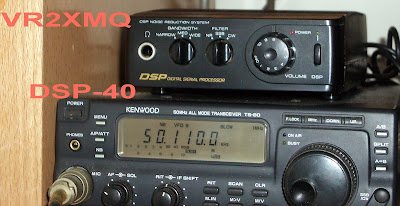
Above: One of my DSP-40's hooked up to my Kenwood TS-60.

Above: Close up of the DSP-40.

Above: A review on the DSP-40 by Steven Johnston, WD8DAS
Modification link for DSP-40: http://www.mods.dk/view.php?ArticleId=3121
Yaesu SP-901P External Speaker: Boatanchor Speaker Now a Steal.
 I have a outboard external speaker that will match up with the Yaesu FT-901DM, the speaker is the SP-901P. It is a bare bones external speaker with no passive audio filtering. The P stands for Phone Patch. A phone patch unit is is built into the speaker and enables the operator to hook it up to the telephone landline and perform phone patching operations.
I have a outboard external speaker that will match up with the Yaesu FT-901DM, the speaker is the SP-901P. It is a bare bones external speaker with no passive audio filtering. The P stands for Phone Patch. A phone patch unit is is built into the speaker and enables the operator to hook it up to the telephone landline and perform phone patching operations. 



Friday, July 4, 2008
A Dear Friend Now Silent Key: Paul Richard Bailey, VS6DO



http://93bmwm5.googlepages.com/vs6dobyw0zv This is a story written about Paul in Radiosporting magazine, February 1987 issue by: Bill Tippett (W4ZV)
Tuesday, July 1, 2008
Where is Tecsun's New S-2000 Receiver.

New Specialized FMDX Radio: Tecsun DSP-2000.

Apparently focus has also gone into the MW performance on the DSP-2000, I certainly hope that it has been gratly improved. It would be a challenge to test it against my trusty GE Super Radio III. The MW loop is the new loop antenna by Tecsun which is basically similar to the Radio Shack and Terk style MW loops.










